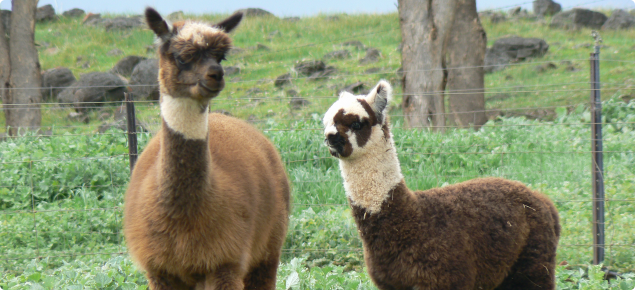Reasons for keeping alpacas
Alpacas as a guard animal
Alpacas are often used as herd guards and are very effective against foxes which might attack lambs or sheep that are down. However be aware that they are in just as much danger from wild dogs as sheep.
As a business
It has been estimated that alpacas are 30% more efficient grazers than sheep.
Income from alpacas is generated from selling animals or their fleece. Many breeders value-add and sell finished products made from their own fleece.
The Australian Alpaca Association (AAA) assists with a centralised collection service for Australian Alpaca Fleece Ltd who ship fleeces directly to Peru for grading and processing into garments.
These are then returned to Australia for sale to the retail industry. The finest fleeces attract the higher value.
Work is underway to develop an alpaca meat industry. Alpaca meat is high in protein and low in fat. Alpaca meat products are already for sale from some businesses in eastern Australia.
Paddock essentials
Alpacas require similar fencing to sheep, preferably without barbed wire and shade in each paddock.
It is important to have a suitable yard or catch pen for welfare checks, to administer injections or to catch animals for shearing.
Fenced laneways between paddocks will help facilitate the movement of animals with minimum stress for animal and owner.
When breeding alpacas landholders need to have quarantine and nursery paddocks.
Nursery paddocks should be situated in a sheltered location, preferably near the house. This will facilitate the monitoring of females as they go into labour.
The quarantine paddock should be either on the boundary of the property or near key animal handling facilities. It should also have wash down facilities.
New or sick animals should be held in the quarantine paddock until they improve or have been vet checked and have excreted any weed seeds they may have brought from their place of origin.
Feed and water
How many alpacas a property can support will depend on what sort of pasture and how much pasture your land is capable of producing. Alpacas will eat about 2% of their body weight in feed per day.
Alpacas should be pasture fed at all times. They do well on native pastures, however alpacas can be supplemented with good quality hay and/or various grains.
Like other livestock, alpacas can also be affected by perennial ryegrass toxicity, annual ryegrass toxicity (ARGT) or phalaris toxicity.
Check with your vet for information on all diseases, the likelihood of occurrence and testing opportunities.
Alpacas need to have access to fresh water at all times. Each animal may drink as much as 4L/day.
Shearing
Alpacas are shorn once a year usually during spring. Shearing is the biggest maintenance task required and usually takes about seven minutes per animal for an experienced alpaca shearer.
Health
Alpacas are relatively disease free, but like all animals they need to be monitored to ensure they stay in optimum health. They are vaccinated twice a year with the same vaccines as used for sheep in the local area.
Alpacas are essentially free from fly strike, foot rot and generally defecate in one spot so have a relatively low worm burden.
When buying alpacas especially for breeding purposes, it is advisable to arrange for a vet check to ensure the animals purchased are healthy.
The alpaca industry employs body condition scoring systems that are similar to those used for other livestock. Regular monitoring of the flock's average body condition is one way to determine the health of animals regardless of how much fleece they are carrying.
Animal identification and movement
All livestock owners within Western Australia must be registered and their stock identified in accordance with the Biosecurity and Agriculture Management (Identification and Movement of Stock and Apiaries) Regulations 2013.
Registered owners will be issued with a Property Identification Code (PIC) card which outlines the properties they have registered to run stock on and the identifiers they may need to identify their stock (e.g. their stock brand and earmark).
Alpacas must be identified before they reach six months of age, or before they are moved from the property, whichever occurs first.
The identification required for alpaca (and llamas) may be all or any of:
- the registered brand impressed on an approved eartag or the registered earmark applied to the right ear of males or the left ear of females
- an approved breed society identifier.
Alpacas under six months of age can move without identification if accompanied by their legally identified mother, and movement is to another property with the same PIC.
Alpacas that have registered identifiers of the previous owner do not require additional identification if the present owner has proof of purchase.
Whenever you transport your animals off your property, you must fill out a waybill, even if they are returning to the same property.
Interesting alpaca facts
There are two types of alpacas, Huacaya and Suri.
These two distinct alpaca breeds share many features, but the key difference between them is their fleece. Alpacas come in 12 colours ranging from white, fawn, brown, grey and black.
Alpacas can live for up to 15 years.
Male: macho
Female: hembra
Young alpacas: tuis
Baby: cria
Average adult height: 90-95cm
Average weight: male - 85kg; female - 70kg
Age at puberty: male 18-36 months, females 12-18 months
Alpaca associations are a good source of additional information.




